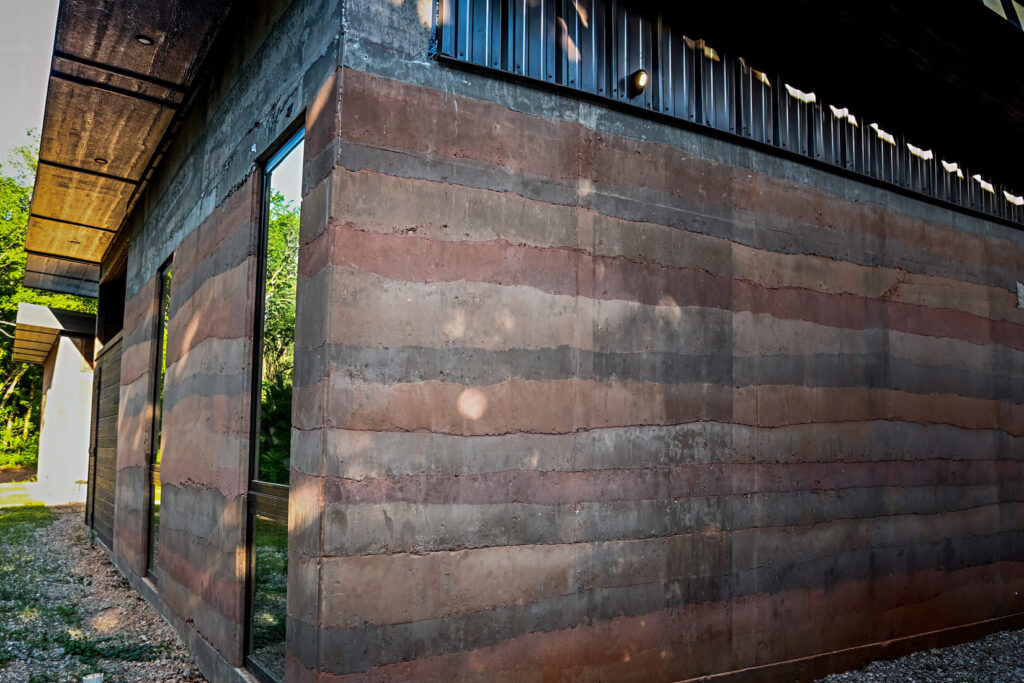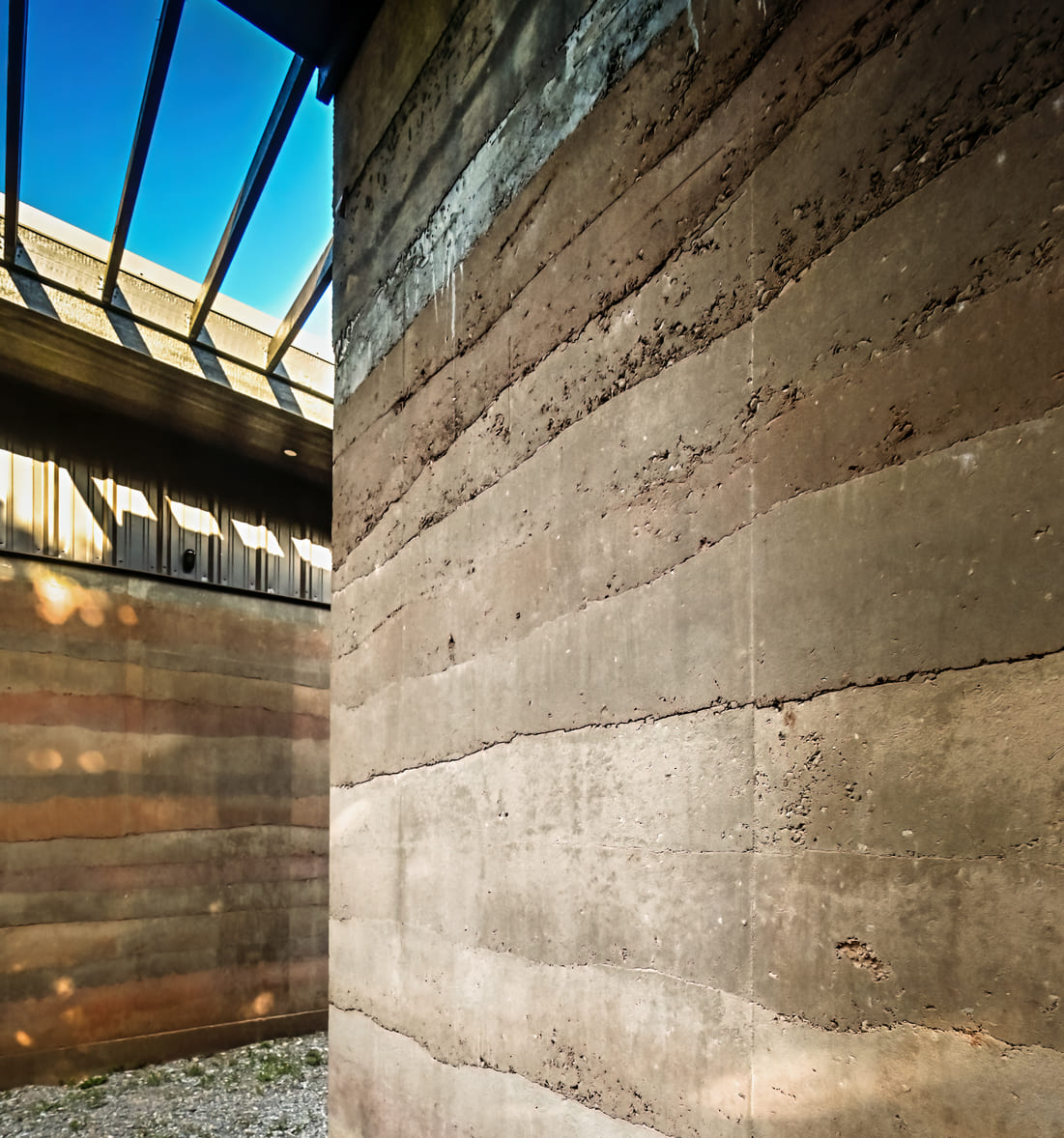Whether you envision creating a serene home, sturdy retaining walls, sleek panels, or even smaller yet charming amenities like mailboxes, planter boxes, or firepits, understanding the intricacies of budgeting for these projects is crucial. We’ll break down the various requirements, intricacies, and estimates associated with incorporating rammed earth in your construction endeavors.
Rammed Earth Home Cost
Rammed earth homes offer a unique blend of sustainability, durability, and aesthetic appeal, but determining their cost involves various factors that must be carefully assessed. Here’s a breakdown of considerations:
Site Assessment
- Location: Regional labor and material costs, local building codes, and availability of skilled labor significantly impact overall expenses.
- Site Accessibility: Terrain, transportation of materials, and ease of construction on the land affect costs.
Design:
- Architectural Complexity: Intricate designs or unconventional shapes can increase labor and material costs.
- Customization: Personalized features or unique architectural elements may add to the overall expense.
- Engineering Requirements: Structural needs, soil testing, and foundation specifications influence costs.


Walls:
- Thickness and Height: Thicker walls or taller structures demand more materials and labor.
- Finishing: Surface treatments, colors, and additional finishes can add to costs.
Size and Layout
- Square Footage: Larger homes naturally require more materials and labor.
- Layout Complexity: The number of rooms, levels, and intricacies in design affect costs.
Windows and Doors:
- Quality and Quantity: High-quality windows and doors increase upfront costs but may reduce energy expenses in the long term.
- Design and Customization: Uniquely designed or customized openings may add to the overall expense.
Fixtures and Fittings:
- Quality: The cost of fixtures, fittings, and appliances can vary significantly based on quality and brand.
- Energy Efficiency: Opting for energy-efficient fixtures might increase initial costs but reduce long-term utility expenses.
Labor Costs
- Skilled Workers: The availability and expertise of skilled laborers in rammed earth construction can impact costs.
- Timeline: Construction duration affects labor expenses.
Miscellaneous Expenses:
- Permits and Fees: Building permits, inspections, and other regulatory expenses.
- Contingency Funds: Setting aside funds for unforeseen expenses or plan changes.
Rammed earth homes often have a higher initial cost due to the skilled labor and specialized construction techniques. However, they also offer long-term benefits like excellent thermal mass properties, durability, and reduced maintenance costs.
Engaging with experienced architects, builders, and contractors familiar with rammed earth construction is crucial for accurate cost estimations. They can provide insights into local factors and assist in making informed decisions to achieve a balance between design preferences and budget constraints.
Rammed Earth Retaining Wall Cost
When considering the cost of a rammed earth retaining wall, several of the above cost factors come into play. Things like materials, labor, design complexity, site preparation, and location, will all affect the final cost Rammed earth walls, known for their durability and eco-friendliness, offer a distinct charm but involve factors that contribute to their cost estimation.
Considering these factors, a rough estimate for a rammed earth retaining wall could range from $50 to $150 per square foot. However, this cost can vary widely based on the specific project requirements and location.
It’s crucial to consult with experienced contractors or engineers familiar with rammed earth construction to get accurate cost estimates tailored to your project’s needs and location. Investing in quality materials and expert craftsmanship often pays off in the long run, considering the durability and aesthetic appeal of a well-built rammed earth retaining wall.
Rammed Earth Amenities Cost
1. Mailboxes: For a basic rammed earth mailbox, the cost can range from $2,500 to $3,500, depending on the design intricacy and size.
2. Planter Boxes: Small to medium-sized rammed earth planter boxes might cost between $300 and $1,500 each, again depending on the dimensions and design complexity.
3. Fire Pits: Rammed earth fire pits tend to be larger projects and could range from $ 4,000 to $8,000 or more, factoring in size, additional features, and customization.
4. Pavers: Costs for rammed earth pavers vary based on size and quantity. Generally, expect a range of $14 to $20 per square foot for materials and installation.
5. Benches: Rammed earth benches can be customized in size and design. Costs may start at $500 and go up to $2,000 or more, depending on size and intricacy.

Rammed Earth Cost Savings Long-Term
- Energy-Efficient Thermal Properties: Rammed earth’s remarkable thermal mass is a standout feature, regulating interior temperatures by absorbing heat during the day and releasing it at night. This natural insulation reduces the reliance on heating and cooling systems, slashing utility bills while maintaining a comfortable environment year-round.
- Longevity and Durability: These structures are built to last centuries, embodying unparalleled sturdiness against weathering, pests, and fire. Unlike conventional homes that might require frequent maintenance or repairs, rammed earth buildings stand resilient over time, minimizing long-term upkeep expenses significantly.
- Cost Savings Over Time: Initial investment in a rammed earth structure yields enduring benefits. The minimal upkeep and repair costs, coupled with decreased energy consumption, translate to substantial savings throughout the life of the building. This financial prudence greatly appeals to homeowners seeking economical yet sustainable housing solutions.
- Resale Value and Appeal: The eco-friendly ethos and unique aesthetic charm of rammed earth constructions often amplify their resale value. The growing interest in sustainable living and environmentally conscious architecture positions these properties as coveted assets in the real estate market, potentially offering higher returns on investment compared to traditional buildings.
- Low Maintenance: With minimal upkeep requirements, rammed earth walls and homes alleviate the burden of constant repairs and renovations, further enhancing their cost-effectiveness. Routine maintenance tasks are reduced, leading to lower ongoing expenses for homeowners and ensuring a hassle-free living experience.



